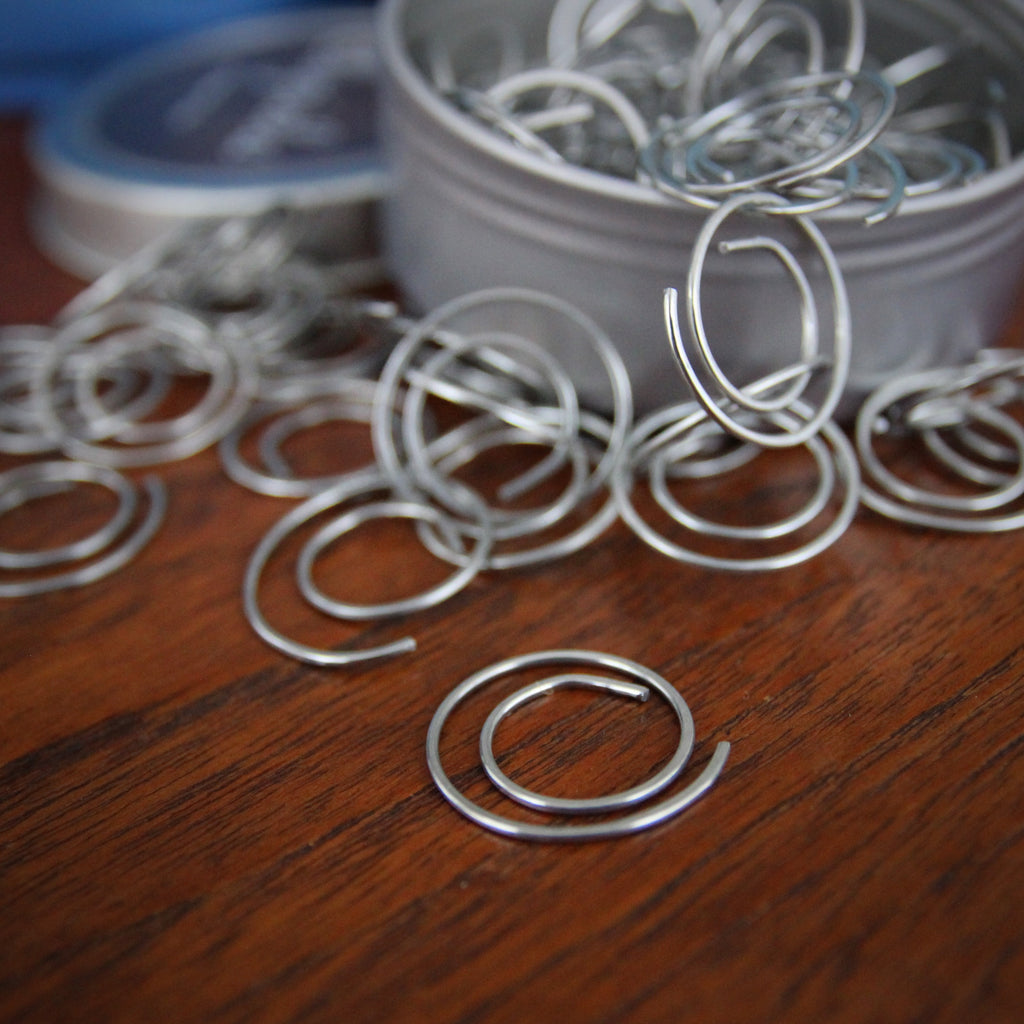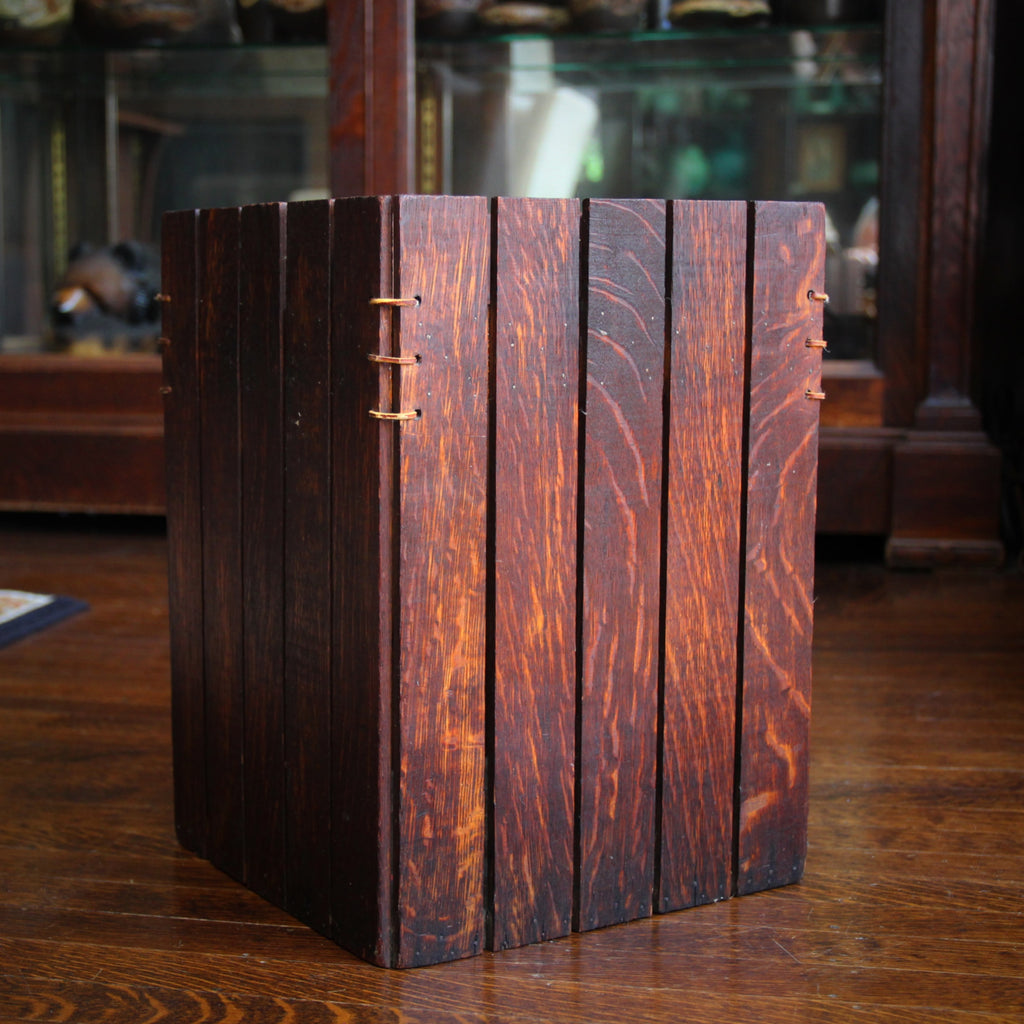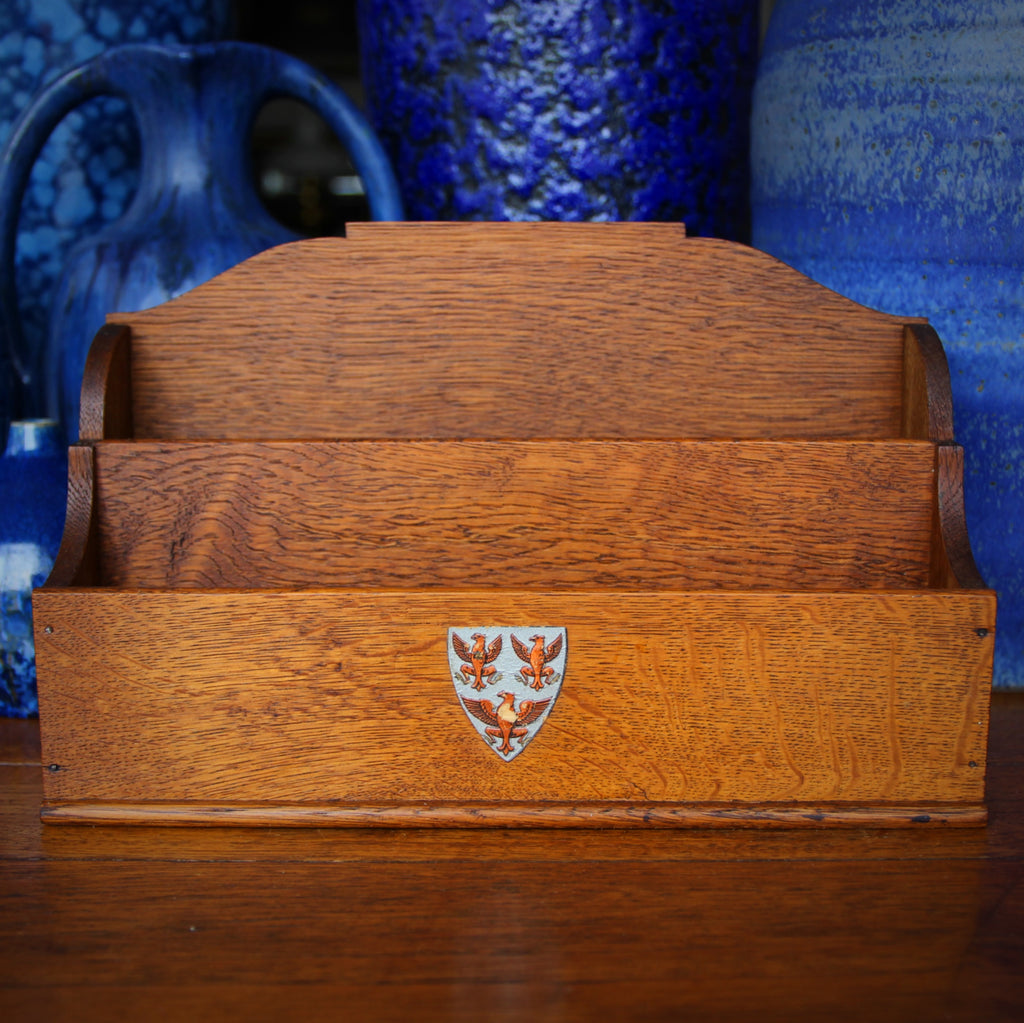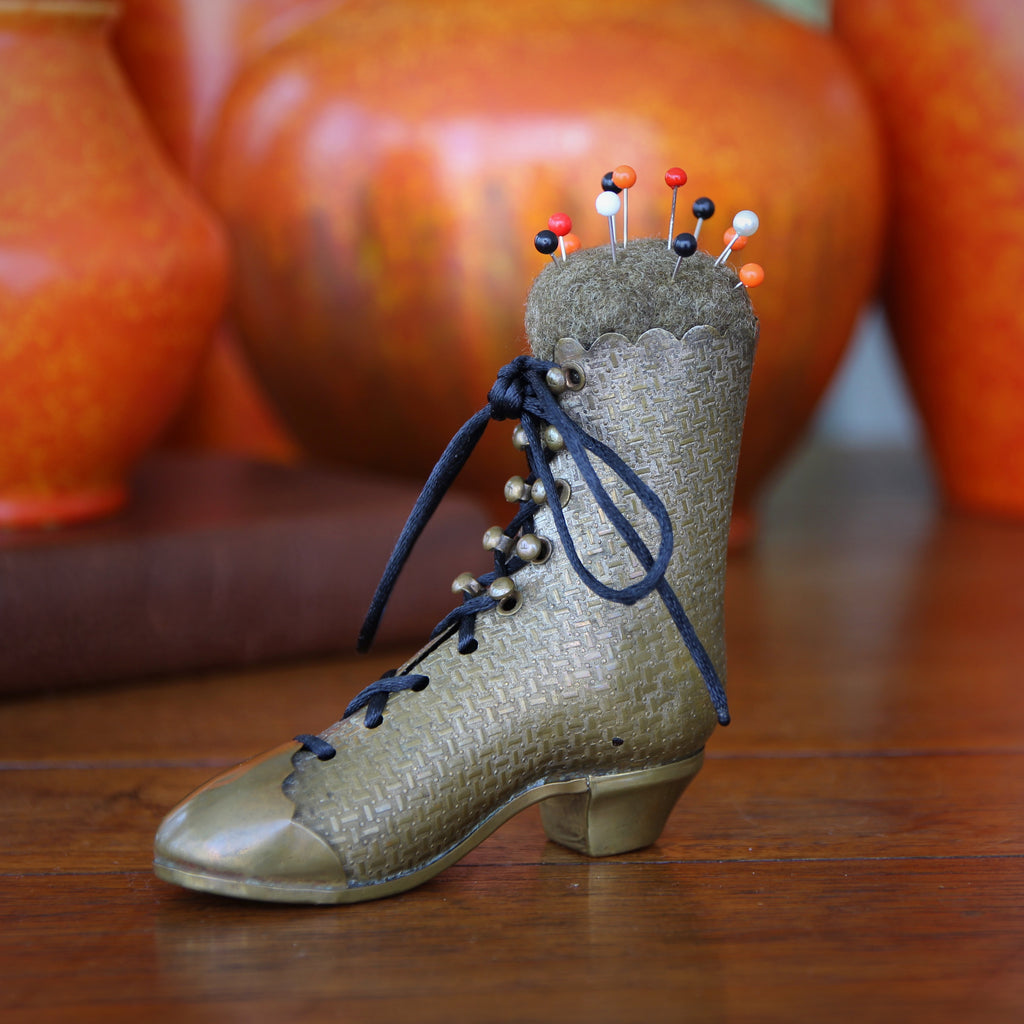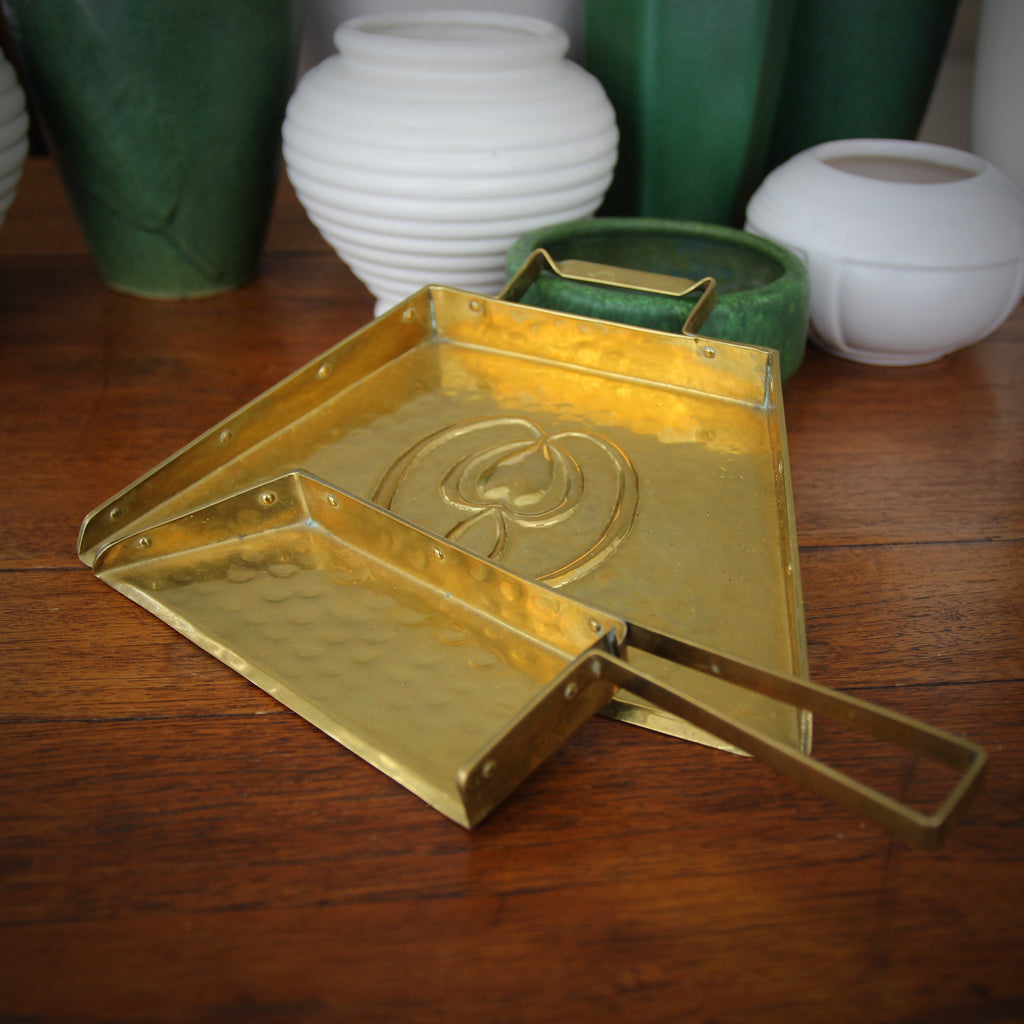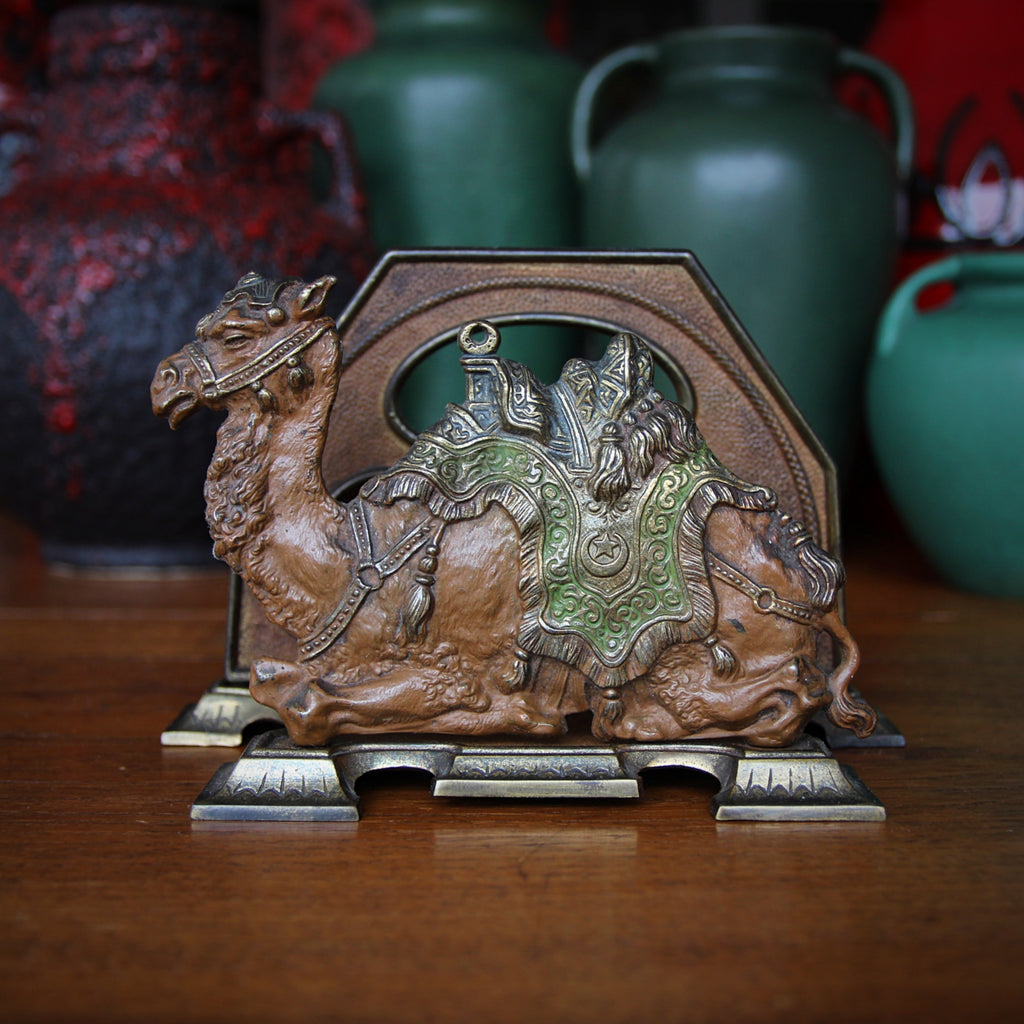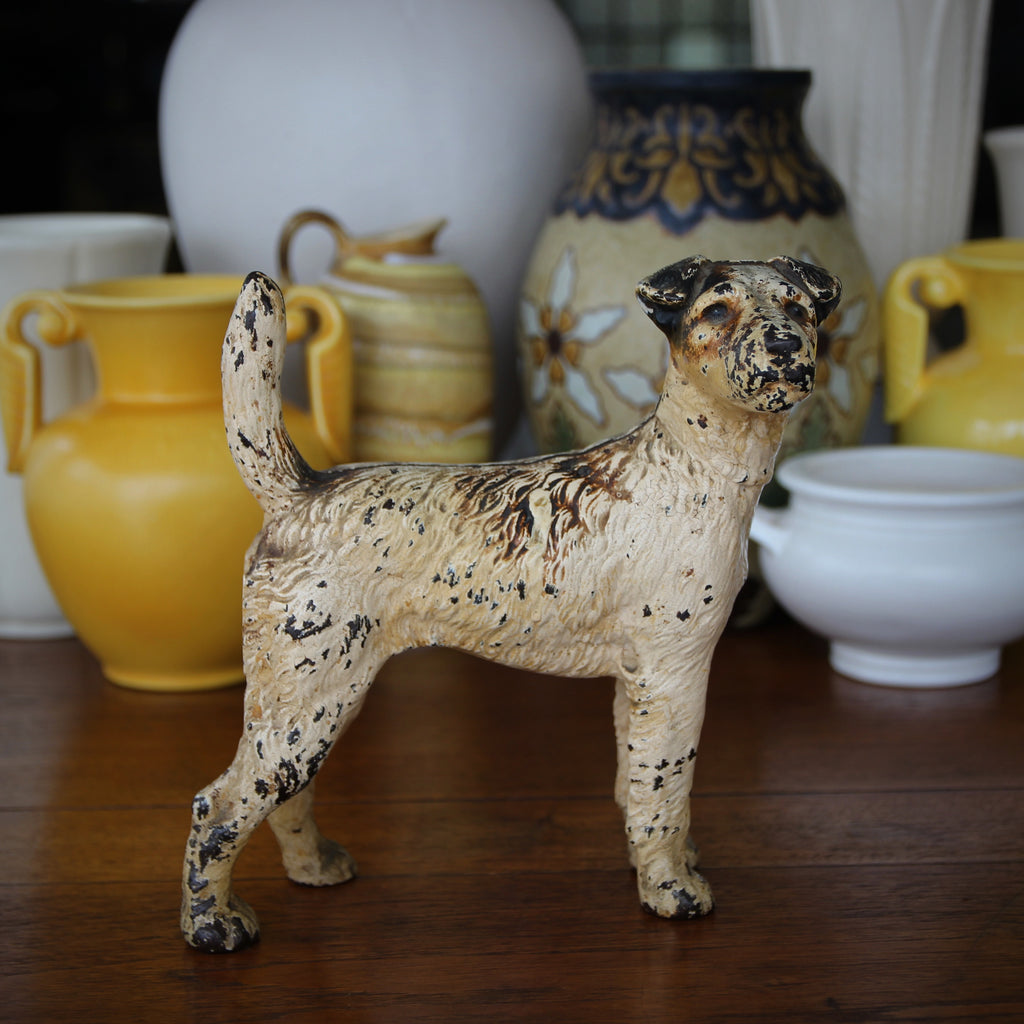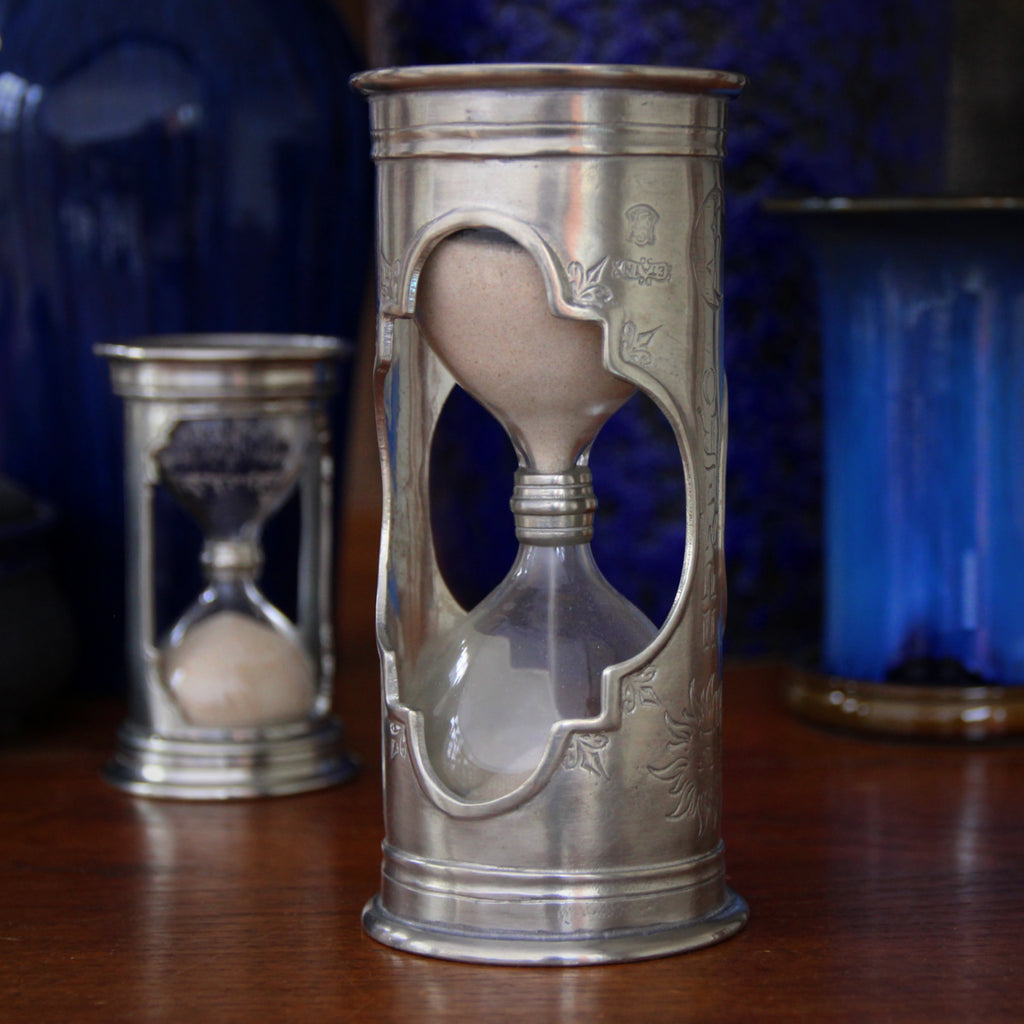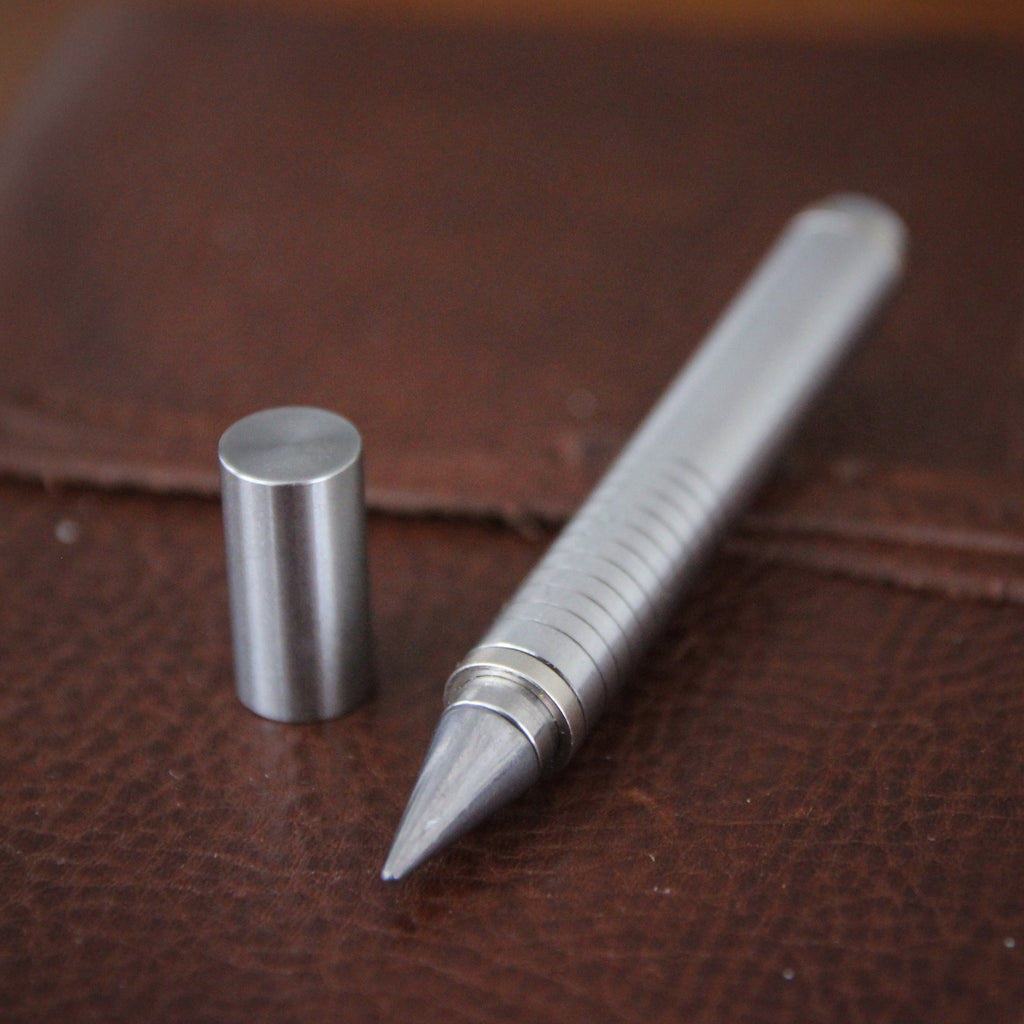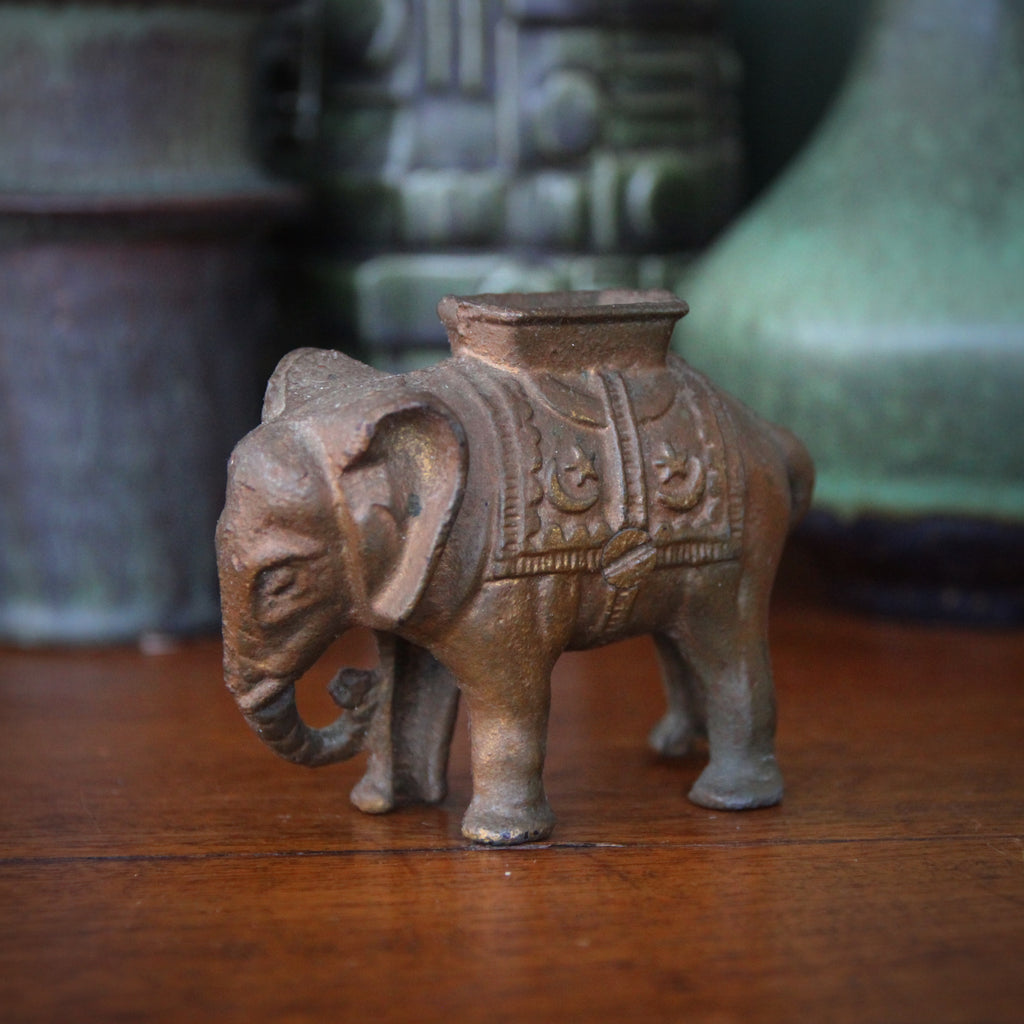JOURNAL — Desk Accessories RSS
An armored night stands atop this Belgian Art Nouveau heavy cast brass letter knife, a souvenir from Belle Epoch Brussels. Part of the allure of Art Nouveau was its "reviving" of earlier, local culture, literature or mythology. The Gothic—the Medieval—was a popular choice in several Western countries. This handsome fellow will add a touch of Gothic Glamour to one's desk. It is also a practical gift—sure to remind the user of a generous friend each time a letter is opened.
Dental Delight
Though modern dentistry has come far in the last 50 years, basic dental hygiene—brushing one's teeth two or three times a day—has been standard practice for decades. In a middle class English home of the 1880's, a toothbrush holder, such as the one above, might have sat on the edge of the heavy porcelain sink. It was made in Burslem, Stoke-on-Trent in Staffordshire—that center of British ceramics production since the 1700's. The handsome Aesthetic Movement decoration is applied with "transferware," a process by which a pattern printed on paper is applied to the ceramic item before firing. This allowed complex or delicate patterns to be quickly (and inexpensively) reproduced on ceramics en masse. The material is called "Ironstone," a common...
Giving Alms
During Lent, Christians are encouraged to pray, fast and give alms—that is, provide money (or other necessities) to those in need. These disciplines prepare the heart, mind and soul for the the joyous season to come: Easter. Sure, almsgiving is (and always has been) important. And not only amongst Christians. But who knew it could be done with such style? This handsome Arts & Crafts alms plate, made around the year 1900, is fashioned from hand-carved oak. The exhortation, "Give Alms of Thy Goods" surrounds the plate and a soft velvet pad is affixed to the bottom of the bowl (to muffle the vulgar rattle of coins). It's a beautiful plate—and one which has done much good, collecting unknown amounts...
Hanging in Style
Oh, for those former days of simple quality! This "Union" brand folding traveling hanger, from the Forties, melds function, quality and style—in one clean stroke. Two chromed-steel wire "wings" rise and drop from a nicely carved beechwood body. Early Modernism at its best. Light, durable and practical (not to mention super-cool), this hanger would fit easily in your carry-on or make a statement hanging on the hook of your office door. Initially, I thought this hanger might have begun its life on the railways, but I have not (yet) found any such connection. I wish I had a gross of these!
Back-to-Work
Spring is coming—and summer "beach weather" will not be far behind. We will not be able to hide beneath those chunky-knit sweaters for much longer. Time to hit the gym! A century ago—when these turned maple dumbbells were crafted—"strength training" was the domain of a very few, hardy souls: bodybuilders, screen actors, circus performers. 25 pound dumbbells were not to be found in everyday homes (or even exercise rooms). What the Edwardians did have, however, were light dumbbells like these—used to augment calisthenics or stretching regimens. A bit of extra weight (a couple of pounds) can make a difference in a prolonged jumping-jacks routine or regimen of "windmills" for the arms. Even if one doesn't intend to use these dumbbells...
Made-to-Measure
Not so long ago, metal spring-roll-up tape measures (which are common today) had not, yet, been invented. Printed cloth tapes might be used for measuring long distances, though two people were required to unroll and pull-taut the soft tape measure. The tape could then be retracted—like winding a fishing spool—into its leather or metal case. For smaller jobs, a boxwood folding pocket ruler, like the one shown above, was de rigeuer. This one, made by Stanley in New Britain, Connecticut, was the go-to tool for many a carpenter, cabinetmaker, or contractor. Stanley made variations on this tool; different styles varied as to their measurement graduations, whether the numbers read right-to-left (or vice versa), and some had add-on features (like bevelled...
Saint Valentine's Day
Valentinus—today known as "Saint Valentine"— was a Roman priest (and possibly a bishop) in Third Century Rome. He ministered to the persecuted Christian locals which angered the authorities and, eventually, led to his arrest. Valentinus was brought before the emperor, Claudius Gothicas, who came to like the priest. But, when Valentinus pushed too hard to convert the emperor, the monarch provided his own ultimatum: the priest must renounce his Christian faith or he would be clubbed and beheaded. The priest refused to renounce his faith and was martyred on 14 February 269. Before he was killed, however, Valentinus is said to have restored the sight and hearing to his jailer's daughter.
Clean Sweep
Christmas is behind us and we are squarely into the New Year. Time to clean-up, re-organize, get sorted! Perhaps the hearth needs a little attention—so active was it during a season of Holiday entertaining. This Victorian English fireplace brush is a handy and stylish way to make quick work of the mess. A soft horsehair brush is concealed within an embossed, heavy brass sleeve. Retract the brass cover and reveal the brush within. It will stand upright in a protected spot (as long as one does not bump it). And the decorative brass work will provide handsome punctuation to your fireplace 365 days a year.
Arts & Crafts Modernism
In some cases, the Arts & Crafts Movement can be viewed as the early stages of Modernism. Simplicity of design and an aesthetic of functionality can be seen in many Turn-of-the-Century Arts & Crafts objects—such as the oak book trough, shown above. Of course, the Arts & Crafts Movement spanned a wide range of countries and aesthetics (with each contributing a different "vocabulary" of design features and styles). But the mission of "honest simplicity" which informed the Arts & Crafts Movement was clearly carried-onward throughout the Modernist school. This "book trough," made of thick planks of oak, is simplicity and elegance itself. Six screws—three on each side—are the only joinery or decoration to be had, save the handsomely cut...
Fair Winds & Following Seas
Over the years, I've bought and sold a fair number of barometers—mostly from England (and most of those using imported German mechanisms). I never gave much thought to whether they were accurate or not. I always assumed they had already been "sprung," to coin a term. In truth, I didn't really have a method of accurately measuring their accuracy except when extreme weather happened to come around. So, when I purchased this nautical "ship's wheel" barometer, I assumed the status quo would endure. But now I have an iPhone—with a fairly sophisticated local weather app. Over the last two weeks, I've been monitoring the accuracy of this barometer (two or three times a day) and, I must confess, I've been...
Cyber Contrarian
It's "Cyber Monday." Of all the manufactured "holidays," this one seems particularly crass, to me. Particularly manufactured. Particularly self-serving. And, although I do make (part of) my living by selling on-line, I cannot bring myself to cheerlead the event.
Instead, I will find and present the oldest, "least-techie" toy in my possession—no screens, no electricity, no internet connection. It's an early 19th century wooden cradle, made to hold a little doll, fastened with old, square nails.
Which makes me think: how many modern toys last 200 years? I have mobile phones and laptops which are obsolete after 15 years!
For those who cannot help themselves, have a Happy Cyber Monday.
Back-to-School - Part XII
Over the past several days, LEO Design has shared some interesting Back-to-School offerings—ideas to help organize, cheer and distract as students push-on through their matriculations. Let's end our parade of offerings with this sweet idea: an Early Twentieth Century shop counter cracker jar, complete with metal lid and metal stand. In Mom & Pop Stores before World War Two, jars like this would have been commonplace—for crackers, cookies, candy, or other foodstuffs. Most times, the metal stand would be long gone, broken or lost. And the stand's design is interesting. It allows the jar to be tilted at numerous angles, as desired. In a dormitory, it would be a wonderful depository for candies, cookies or other treats which need protection. In...
Back-to-School - Part XI
It happens to most of us. At 45? 50? 55? We start to notice that all the font sizes have suddenly shrunk. Inexplicably, someone down-sized all the print! Add to that: all those Twenty-Something tech wizards—who think they will never age—design the world's electronics and packaging and graphics with the assumption that "old folks" aren't interested in adopting their technology. Hence more teeny-tiny "buttons," micro-links and fine print to scrutinize. Well, sometimes old-time solutions will still solve new-age problems! Thus, one can never have too many magnifying glasses scattered around the house. In the bathroom for reading bottles. Near the TV for reading the PBS guide. Or in the glovebox for checking receipts. (Those mundane tasks which populate the pursuits of...
Back-to-School - Part X
Sometimes an ordinary paperclip will do. In fact, most times the classic clip will suffice. But—every now and then—an extra splash of style is required. For these moments, may I suggest these Italian spiraling paperclips, called "Chiocciola" (which is "snail" in Italian). A tin of these in your desk may provide that little extra element of interest to your resume package, note to an important customer, or proposal to a prospective client. They also look great sitting in a little bowl upon the desk—awaiting their next assignment.
Back-to-School - Part VIII
For the last several days, LEO Design has been sharing some interesting Back-to-School offerings—ideas to help organize, cheer and distract as students push-on through their matriculations.
Style meets Function with this Edwardian English brass and oak letter rack, circa 1905. Simple swirling metalwork stands atop a wooden plinth, finished with a moulding edge. It's sized just-right for holding a supply of stationery and envelopes, bills and documents to be processed, or to do lists and other reminders. A small measure of sculpted motion means just the right amount of visual interest. Otherwise, the piece exhibits pure Edwardian utility.
Back-to-School - Part VI
So much for "the paper-free society." There is nothing as durable and conspicuous as a hand-written note posted in a prominent place. To do lists. Reminders. Addresses. Good wishes. Having a small piece of notepaper at-hand is always convenient and efficient—including in a productive dorm room. This polished pewter notepad holder was designed by Erik Magnussen (Danish, 1940-2014) for Royal Selangor. The 4"x 4" replacement notes can easily be purchased on-line or can be cut-down from recycled copy paper.
Back-to-School - Part V
Over the past several days, LEO Design has been sharing some interesting Back-to-School offerings—ideas to help organize, cheer and distract as students push-on through their matriculations.
In terms of sheer indulgence, this Arts & Crafts wastepaper basket wins the "Dorm Room Makeover Challenge." Made of slats of quarter-sawn oak, it is finished with rawhide lacing at the corner tops. It's the handsome, finishing touch beneath that built-in dorm room desk. (Or under that costly Stickley writing table.)
Back-to-School - Part IV
It's been said that "Time is Our Most Precious Commodity." Each day is allotted only a fixed number of minutes—and as each moment passes, it is gone forever, never to return. More time cannot be purchased at any cost, regardless of how rich one is. And further complicating things: though each of us possess a "bank" of time left on Earth, none of us knows his bank balance. Wise people think about and plan the use of their time. If a high school senior does not, yet, appreciate the value of her time—and the challenge of managing it—a college freshman will soon be made aware. Packed course schedules, layers of projects with varying due dates, and all those enticing extra-curricular...
Back-to-School - Part III
For better or worse, some Americans cannot (or will not) separate their favorite academic institutions from the institution of American Football. The Autumn—with its sweaters, crisp temperatures, and crackling leaves—means Back-to-School and the start of Football season. Tailgates, marching bands, gambling brackets. Some schools (and student bodies) are better known for their American Football prowess than they are for their academic achievements. Personally, I'd prefer a world where educators prioritized educating—and sports games were just a casual, weekend distraction. But such is a minority view amongst the concepts of conferences, school budgets and broadcast rights. Shown above, a Japanese crystal American Football sculpture, made by Sasaki. It could be used as a paperweight on the desk or an interesting conversation piece in...
Back-to-School - Part II
Who can't use a little more organization at the desk or in the dorm? Or office, kitchen or craft room? This Edwardian English oak stationery rack, circa 1905, is meant to hold a supply of writing paper, envelopes, cards and letters. But it's a very handy place to organize your paper-in-motion. I use mine to hold paid bills (checks written, envelopes stamped and sealed) while waiting for the correct day to mail them. Documents, brochures or articles which need attention also call to me from their oaken stand. In large families, it might be a good place to leave member's mail—or, perhaps, provide a little "in-box" for intra-family communication. The organizational uses are many. And the stand looks so handsome...
Back-to-School - Part I
The school bell has rung! Pupils to their desks! While college freshmen may have encountered wistful parental partings, grade school returnees likely perceived their parents breathing a muted sigh of relief. Such is the annual tide of school-going: students flow in and out of their institutions with seasonal regularity. Like water, the droplets are always changing though the tides themselves remain regulated. Over the next several days, LEO Design would like to share some interesting Back-to-School offerings—ideas to help organize, cheer and distract as students push-on through their matriculations. I've sold dozens of English bells over the years, many of them styled like the one shown above, a Late Victorian Aesthetic Movement design from the 1880's - 1890's. This one, however, is the...
Welcome, LEO!
Today is the first full day of LEO—acknowledged King of the Zodiac! The Sun entered "LEO airspace" overnight and it will remain there through 22 August. The LEO zodiac sign holds much significance for us. The shop, as you can see, was named after the regal lion. And the store was built and opened during the LEO period (though I gave myself a "short day" on my birthday). And LEO marks the highpoint of Summer. Who doesn't like Summer (at least a little bit)? LEOs are known for their energy, adventure, gregariousness, their generosity and their affinity for the limelight. They love being in-charge, especially if they have a First Mate close at hand (and especially a loyal Taurus)....
The Best of Intentions
I bought this Edwardian travel magnifying glass twenty years ago, thinking it had such convenience and style—not to mention, impressive magnification. The style was simple and cool. The leather case possessed much character. And the lens was powerful, indeed. It went into a drawer, awaiting the day when my little plastic loupe finally gave-up-the-ghost (or was lost). That day never came. Thus, two decades later (while cleaning-out my desk drawers), I found the magnifying glass again and decided it was time to allow it to find a new home—with a more active user. This is not to say that I haven't appreciated it under my possession. It was made by the American Optical Company in Southbridge, Massachusetts, around 1910. The...
It's SOOO Hot!
Whether you live in London or Lisbon or Lubbock...it's soooo hot! What would be nicer than taking to the water—sailing across a cooling bay or mountain lake? Step aboard! Certainly, your generous host needs a little gift, a token of your gratitude. Give the captain a pair of "Sailor's Decision Makers": a pair of cast pewter tokens which can be flipped to make your choice—"Sail" or "Get Off the Yacht."
Attention to Detail
Immigrants to America have continually "refreshed" our country—its culture, its food and its gene pool. Many of those immigrants have conceived new ideas, creating business opportunities for themselves, their employees and their communities. One such immigrant was Adolph M. Holstein, a German Jew who moved from Warsaw, Poland, to Syracuse, New York, where he founded the Syracuse Ornamental Company in 1890.
Adolph was an accomplished, European-trained woodcarver. Once settled in Upstate New York, he invented a new product, "SyrocoWood," which revolutionized the home-building trade of the late Victorian Era. Prior to his invention, high-quality carved wooden items required slow processing in the hands of a highly-skilled woodcarver.
Tea Time!
It's difficult to think of an England without tea. But it was only about 400 years ago that tea began to be imported to Europe on a regular basis. In the 1500's, Portugal first made contact with China. Missionaries and traders were introduced to the "bitter red beverage" which was popular with wealthy Chinese. Small quantities were brought back to Europe, perhaps for a monarch or aristocrat, after which the popularity of tea sparked a huge tea-trading scramble—initially in Portugal, the Netherlands and (a little later) England. History tells us that Catherine of Braganza (Portugal) brought tea with her when she arrived to marry King Charles II of England. And, boy, did it take off from there! During the 18th...
Summer School
Just because class has been dismissed for the summer, one need not cease the learning. Bring a touch of the schoolhouse into your home with this early 20th Century two-sided, wood-framed slate. Larger than the traditional "student tablet" variety, it was probably used upon the desktop (not the lap). And, if you can't bear the thought of jumping-back into the classroom so soon, this blackboard would make a great, old-fashioned "family communication" center in the kitchen, study or mud room.
Humble Beauty
One would think that a wastepaper basket would be a very modest possession. And, indeed, it usually is. This handsome receptacle is the exception to that expectation. Crafted around 1910, it is simply-constructed of strips of quarter-sawn oak. Rawhide lashings near the top are the only visible (functional) embellishment. Over the years, I've sold a number of nice Arts & Crafts wastebaskets. It seems that customers view such a canister as the important finishing touch to a nice Arts & Crafts or Turn-of-the-Century desk. Though over 100 years old, this wastebasket remains in fairly solid condition—though I would always handle such a nice, old beauty with tender care. With TLC, this wastepaper basket may provide another 100 years...
Queen's College
Queen's College, part of Oxford University, was founded in 1341. It was originally intended to educate clergymen for the distant reaches of Northwest England, snuggled just under Scotland (today designated Cumbria County). In addition to clergy, the school also began to educate sons of the nobility and a good number of "poor boys" who were smart but could not have afforded an expensive education. The school was named after its patroness, Queen Phillippa of Hainault. She was married to King Edward III and served as his political advisor and regent (while he was away during the Hundred Years' War). The school is known for its handsome architecture, some of it designed (or influenced) by Sir Christopher Wren (1632-1723) and Nicholas Hawksmoor...
The Mailboat Cometh
In 1950, US households received twice-daily mail delivery. Businesses, especially in cities, might receive three deliveries a day. Written addresses were checked and any mistakes were cheerfully corrected. And postal drop boxes were emptied multiple times a day—even on Sundays. 72 years later, our experiences (and expectations) regarding the Post is quite degraded. And it's a shame: only can a large and well-managed system (like a USPS) deliver quick, safe and inexpensive delivery. "In the olde days..." some mail might have arrived by boat, from overseas or to remote, watery locations. The English hand-hammered brass letter holder, shown above, would have hung on a Twenties British wall—holding mail (either incoming our outgoing). The Art Deco lettering indicates a post war...
Countdown to Father's Day - VI
For the handy Dad: a British "shop class" hand truck with wheels made from early Twentieth Century coins. Probably made by a young English tradesman (learning his trade), it is just the right size to hold a supply of business cards.
Countdown to Father's Day - II
For the Dad of Mettle: a three-dimensional puzzle of finely-engineered solid brass. Once it's securely reassembled, it makes a great paper weight and an even better conversation piece. Solid, well-assembled and just a little heavy. Just like Dad.
Oh, For the Good Ol' Days...
Remember "The Good Ol' Days"? When airborne maladies were vanquished with a simple little sweetie? Whether this was truly the case—or just wishful thinking and deceptive promotion—this English Thirties "Flu-Nips" apothecary jar would have stood at-the-ready on the counter of druggist, barber or candy shop proprietor. A handsome graphic label (presenting a red cross) sits beneath a red bakelite screw-down lid. Its soft square shape provided shipping efficiency; the maximum amount of product could be shipped in the smallest possible box when square vessels are snuggly packed together in a multi-bottle carton. Click on the photo above to learn more about it. Though our Greenwich Village store is now permanently closed, LEO Design is still alive and well! Please visit our on-line store...
Flowers for Mom - VI
The Japanese have a sophisticated crystal-making industry which really blossomed after World War Two. Glassmaking is notoriously labor-intensive—which contributes to the traditionally high price of fine crystal. After the war, countries like Japan (and Germany) found themselves with a large workforce desperate to get back to work. And, with a relatively low labor cost, Japan was well-suited to develop attractively-priced, high-quality goods for an international market. In the decades after the war, high-volume, labor-intensive manufacturing moved from the victor countries (like America and England) to the vanquished countries (like Japan, Italy and Germany). Ceramics and glassware were some of the industries which saw such large-scale global shifts after 1945. To its credit, Japan made a great effort to elevate the quality...
Countdown to Mother's Day - X
We've been counting-down the days to Mother's Day with an assortment of thoughtful gifts for the important women in our lives. Be sure to request gift boxing, if you'd like it. We can also ship directly to your mother, possibly saving a few days in-transit. (Please be sure to specify your desired greeting for an enclosure card to accompany your gift.) A beautiful and functional letterknife is always a welcomed gift. And this one, shown above, is extra special. The handle is finely cast pewter, selectively gold-plated and enameled with a light olive green. To complete the design, hand-set Swarovski crystals are mounted into the handle. The nicely-shaped brass blade provides the working end of the implement. Click on the...
Countdown to Mother's Day - VII
We're counting-down the days to Mother's Day with an assortment of thoughtful gifts for the important women in our lives. Order early and be sure to request gift boxing, if you'd like it. We can also ship directly to your mother, possibly saving a few days in-transit It's time to let our mothers kick-back, relax and demand a little service for themselves! This Edwardian English tea bell may give her the assist she needs. Tea bells were a fixture in British middle class households—back in the days when "middle class" meant a houseful of servants. Kept on a side table or tea tray, the bell would be used to summon the help quickly and discreetly. The specimen shown here, made of bronze "bell...
Countdown to Mother's Day - IV
Everyone can use a little help organizing, especially busy moms. So much the better to help her do it with style.
This Edwardian English letter rack is made of brass mounted upon an oak base with handsomely chamfered edges. A swirling bale handle emerges energetically from behind brass botanical panels. Such a letter holder can be used on a working mom's desk or in the household: a place to sort mail, keep lists, save recipes, or store envelopes until they are ready to be mailed. The handsome design elevates these otherwise mundane tasks—and will add a bit of visual interest to her office, den or entry hall table.
Countdown to Mother's Day - III
Once upon a time (and not so long ago), sewing was a basic skill familiar to most households, especially (but not only) amongst women. While at-home dressmaking and tailoring was coming to a quick close after World War I (when "ready-to-wear" in department stores became quick, easy and affordable), most mending and altering of garments still could take place in the hands of a talented amateur. Every house had a drawer, box, or cake tin which held the needles, pins, seam-rippers and thread required to replace a button, mend a seam, or darn a sock. It was during this period, just before World War I, that this pincushion would have been in-use. The pincushion shown here is Edwardian English, made around 1905....
Light My Fire
Back in "the old days"—a time period which includes the Arts & Crafts period—maintaining and managing fire(s) was an important task. Fires might be used for lighting, cooking, heating, manufacturing and other industrial tasks. And sometimes one needed to "transfer" (or spread) a fire from one place to another. In a wood-burning fireplace or stove, a "Cape Cod" style "fire starter," like the one shown above, was a useful tool to have in the household. The "pitcher"—this one is hand-hammered steel in the Arts & Crafts style—would hold a supply of lamp oil. A wrought-iron "wand," with a soapstone "egg" at one end, would soak in the lamp oil, thus absorbing a good amount of the fuel. This wand would...
The Sign of Peace
From ancient times—in Mesopotamia, Ancient Greece and Jōman Era Japan—the dove has been used as an important cultural, religious, and aesthetic symbol. Even today, the world's biggest religions (and Paganism, too) all use the dove, usually in the role of messenger, symbol of purity or harbinger of peace. In the Jewish Old Testament, Noah releases a dove from the ark which returns with an olive leaf in her beak, a message to Noah that the flood waters have begun to recede. The Christian Gospels refer multiple times to a dove which symbolizes the Holy Spirit—or, more specifically, the Holy Spirit descending to Earth. Even in secular language, a person is called "dovish" if s/he prefers peacemaking to taking-up arms.
The Tax Man Cometh
Two weeks from today—18 April 2022—is Tax Day, that annual heavy lift that we keep putting-off 'til the last minute. For me, it is also the annual season of resolution: resolution to organize myself and "never go through this again!" To that end, here's a small solution. (A very small solution.) This little bronze Arts & Crafts organizer, made by Silvercrest (c. 1920), could make your organizing just one little bit easier. The bronze has a mottled and textured surface and is enhanced with an applied silver scrolling pine motif. It could hold fresh stationery, payments to be mailed, or envelopes containing receipts for tax time.
Technology Face-Off
Technology—and the corporate campaign to exploit it—transforms and adapts to satisfy the "needs and opportunities" of the times. Sometimes a "face-off" ensues: as technology marches forward, new businesses blossom and grow while other businesses wither and fall-away. Over the last 150 years, industry has responded (multiple times) to the way society reads and collects information. Let's close-out the month of March with this interesting bookrack, made shortly after the Turn-of-the-Twentieth-Century. Before the Industrial Age, there were very few people in the Middle Class. There were a handful of land and factory owners and a mass of people who worked for them. Though people were taught to read, only the wealthy could afford to collect many books. A private library was only within...
Beautifully Receptive
Yesterday we shared a French ceramic "comb dish"—once used to neatly tuck-away a comb on the dresser, washstand or vanity table. Today we share an Edwardian English "hair receiver." An object like this would be found on many an upper class woman's dressing table. As a woman brushed-out her hair, probably before bed, and loose hair collected in her hairbrush, she would gather that hair and stuff it down into the hair receiver. When a sufficient amount had been accumulated, she would send it to a hairdresser who would fashion it into a hairpiece. That ornament, made of her own hair, could be worn by the woman to supplement her hairstyle. This turned ebonywood hair receiver is topped with an engraved...
Hidden Treasures
During the Victorian Age, there was an object dedicated to every possible use. This was especially true when it came to food service: celery vases, spoon warmers, berry bowls. But personal care and tidiness also enjoyed a wealth of strange and specific objets, like the French ceramic "comb dish" shown above. This ceramic covered bowl, decorated with a handsome Greek Key transfer print, would be stationed at a vanity table or upon a dressing table—providing a place to store one's comb between uses. It would contribute a measure of orderly process to one's morning ablutions. At a woman's grooming station, there also would be a "hair receiver," a small canister into which she could push the loose hair pulled from...
Ode to a Shrinking Font Size
Every year, it seems, the fine print on boxes, documents and mobile phones gets smaller and smaller. Is Kellogs attempting to use less ink? Perhaps Apple is trying to conserve pixels? Never mind, I say. Just start a collection of magnifying glasses—and position them strategically around your home and office. This brass-framed magnifying glass is nice and strong. The antique patina provides a handsome finish.
School's Back
To the delight of parents nationwide, "real" school is back, at least for now. After months of video classes, isolation and hoping for a children's vaccine, it seems that the morning school bell has finally rung.
The school bell, shown above, was made in England in the late Nineteenth Century. It is made of a type of bronze—sometimes called "bell metal"—in the Aesthetic Movement style. Horizontal etching on the body becomes horizontal ribbing on the shaft—carried-through to a turned, ribbed ebonywood knob at top.
Puzzled
Art meets engineering meets intriguing plaything. This finely-engineered and beautifully sculpted "toy" could stand-alone as an objet d'art on your desk. It would certainly make a nice (and heavy) paperweight. But it is also a puzzle; its meticulously-honed solid brass members assemble into the geometric shape you see above. Made in Brooklyn, this little work of art will prove hard to resist. Visitors to your office will be unable to not pick it up!
Tracks in the Snow
While Spring will be here in less than two weeks, there's still a chance that we may see a bit more snow. And, where there's snow, we find foot tracks. Human tracks, including the occasional skid mark. Doggie tracks, occasionally turning in circles. And the random tracks of wildlife—rabbits, squirrels, birds, deer and other indiscernible creatures—which "violate" the perfection of a new-fallen blanket of snow.
My "new" neighborhood in Pittsburgh adjoins the University of Pittsburgh—in a fairly well-urbanized district called Oakland. There are plenty of deer in the nearby Schenley Park, however, they rarely venture-out into the urban bustle.
Tuesday, Two Twenty-Two Twenty-Two
We interrupt our regularly-scheduled programming (Victorian cufflinks) to make note of this exceptional day: Tuesday, Two Twenty-Two Twenty-Two!
Two golden (polished bronze) eggs sit in this rustic cast-bronze nest, lovingly crafted in Canada. Such an interesting desk item will certainly provoke visitors to pick-up and fondle the clutch. The nest, alone, would make a perfect clip holder, ring saver or place to throw your keys near the door. And, of course, the two eggs will forever commemorate this special date.
And now: back to our regularly scheduled programming...
Pulling it Together...
Though it seems I've only just packed-up my Christmas decorations, the next big deadline looms: getting my tax information to my accountant! This always seems like a big lift: all that digging, all that sorting, all that collating. But, usually, the anticipation is far more painful than the actual process. Usually I can get everything together in 8-10 hours—one long day (or two short days). Then I can return to The City of My Dreams (New York) to meet my accountant and dump everything on him. Why not organize in style? Shown above, metal paperclips from Italy—curled like little snails, "chiocciola" in Italian. Approximately 125 clips come in a little round, aluminum box. Certainly your accountant will be impressed...
Six Months 'til LEO!
Six months from today—on 23 July—the sun in the heavens will enter the zodiac constellation of LEO, which is, naturally, my favorite sun sign. This also means that we've recently entered the zodiac sign of Aquarius—which is the "polarity" (or polar opposite) of the LEO birth sign on the annual "wheel of zodiac signs." In Greek mythology, Aquarius provides a remarkable story. Tros, the King of Troy, had a beautiful son. He was so beautiful, in fact, that Zeus (the King of the Gods) wanted him for himself. One day, while the youth was tending his father's flocks upon Mount Ida (in Phrygia, modern day Turkey) Zeus took the form of a giant eagle and swooped-down to carry-off the young...
The Great Clean-Up
Most years, during the first couple of weeks of January, we've always tried to squeeze-in as many friends as possible for small dinner gatherings. Mostly we wish to see them after the busy holiday season. But we also want to make the most of our Christmas decorations before we put them away for the year. What good becomes of hours of work decorating when only a small handful of people get to see them? Alas, this year, the coronavirus has quelled our plans to open our house too widely. And the time has come to take-down, box-up and stash. 120 years ago, the English Arts & Crafts "crumber," shown above, would have been a customary sight at the dining table. The two...
Snowfall!
At this early point in the season—three weeks from winter—we've already seen frequent dustings of snow, though none of it has "stuck." But just give it time! Before long, we'll be heading outside, shovels in-hand.
This French crystal paperweight, probably from the Eighties, depicts a delicate snowflake—"frozen" for all time. And unlike the white stuff outside, this snowflake won't melt. It will provide a reminder, year 'round, of the cool, crisp season which is certain to return.
When Do We Leave?
The Feast of the Epiphany—also called "Three Kings' Day"—is on 6 January, four short weeks from today. The camel above might be asking, "When do we leave?" Well, actually, he probably should have left a month ago (if he were walking). The Gospel of Saint Matthew tells us that an unspecified number of "wise men" came "from the East," in search of the new king, having "observed his star at its rising." The Western convention of three magi probably derives from the fact that three gifts were presented to Jesus: gold, frankincense and myrrh. Their precise origin is not specified, though early Christians associated them with Zoroastrian priests from Persia (who were accomplished in their knowledge of astronomy). In recent centuries, the "Three...
The Tea Which Built an Empire
Reid, Murdoch & Company was founded by two Scotsmen in Chicago in 1853. They built a food supply empire—and championed the survival of "Mom & Pop" grocery stores from coast-to-coast. During their roughly 100 years in business, which was a time when large grocery chains gobbled-up (or displaced) small food stores, Reid, Murdoch insisted upon only selling to small retailers (not chains). They had a wide range of products, sold under the Monarch label, which gave small stores well-priced, quality items. Because their goods were sold in thousands of small shops nationwide, these small retailers enjoyed an economies-of-scale (a buying power) which allowed them to compete with the larger, more powerful chains. Jams, pickles, coffees, teas, cocoas—sold across the country—paid...
Door Guard
In 1894, John E. Hubley opened a metal casting workshop in Lancaster, Pennsylvania. His product line was metal industrial parts for electric trains. Come 1909, finding that business was slack, Hubley converted his production to cast iron toys and home furnishings objets: animals (especially dogs), bookends (many of them dogs), and doorstops (more dogs). Hubley also cast vehicles—from horse-drawn carriages (earlier on) to scale model automobiles (later in the company's life). At its peak, Hubley was the largest metal toy manufacturer in the United States. The terrier doorstop, shown above, is composed of two separate sand-cast iron parts (the left side of the dog's body and the right side of the dog's body). Each dog began its life as two...
A Close Shave
Robert Vom Cleff immigrated to New York City from Germany in 1867. In 1873, he founded a business at 105 Duane Street, importing German scissors, knives, surgical instruments and razors, like the one shown above. When he died in 1907, the business was run by his widow and son until they sold it in 1926.
This steel straight razor blade, imported from Germany, was fitted with a celluloid handle—manufactured and "carved" to appear like ivory. It is accompanied by its original box from the turn-of-the-century.
Hoo's Nou?
Three of my favorite things converge in this handsome object: owls, pine and Art Nouveau! Add to that a fourth thing: organization! This American Art Nouveau letter rack has it all. At center stands a handsome "Wise Owl"—the ancient symbol of knowledge and intellect. He perches on a pine branch, festooned with sprays of pine needles and clusters of pinecones. And he's framed, at center stage, within an Art Nouveau "whiplash" proscenium arch. The cast iron letter rack is finished with an aged brass patina, through which copper highlights peak through. It was made in the 1910's or 1920's by Judd Manufacturing in Wallingford Connecticut.
Welcome, Libra
The Sun "entered" Libra last night at 7:21—making today the first full day of that gracious sunsign. Libra will continue through 22 October, at which point Scorpio takes over.
It is no coincidence that Libra begins on the day of the Equinox—the day on which the sunlight balances the darkness. Balance is at the heart of the Libra sunsign (which is symbolized by the Scales of Justice). Those scales come from Themis, the Ancient Greek personification of Divine Law (which was not to be confused with Human Law). She holds the balance of justice, as does her more modern incarnation, "Lady Justice" (seen in later Western cultures).
Pins & Needles
If you must have "Pins & Needles," this is the way to go. A cast pewter "Oxford Shoe"—made in the Twenties in Japan—is fitted with an interior pincushion. It provides a handsome and handy way to keep your sewing supplies organized and ready-at-hand.
Seeking Still Waters
What could be nicer on a glorious summer day—perhaps in the early evening, before the sun has disappeared—than to row across a placid lake, surrounded by trees and mountains and birdsong? This little pewter rowboat is finely modeled and very well cast. It is perfect for holding clips, candies or cufflinks—or, best of all, business cards. It could be the perfect little gift for a boat-loving friend (who still has to go to the office).
Oh, For The Good Old Days . . .
Product packing can be many things: it can be attractive or ugly; it can be protective or ineffective; it can be thrown-away immediately or re-used for years to come (or decades or a century). This "package," an Edwardian English biscuit tin, originally would have contained cookies (maybe as a gift), over a century ago. Topped with a white ceramic knob, it was made to last—with great style and utility. Perhaps a paper label once surrounded the walls of the canister. But good design and good taste have left us with a handsome vessel which can still be used 12 decades later. Oh, that today's packaging designers would produce work that is so nice, so useful and so worthy of saving. Click...
A Stitch (Back) in Time
Over the years, I've sold a handful of pincushions—all functional, some decorative, too. But this offering is something altogether different: a wall-mounted pincushion, carved in Switzerland in the traditional (and handsome) Blackforest manner. It was crafted in the early part of the Twentieth Century and was likely purchased as a souvenir (or souvenir gift). The darkly-finished, scrolling branches and leaves emulate the more-masculine aesthetic seen in other Blackforest carvings. But it is likely that a woman sat next to this handsome pincushion, working on her embroidery, needlepoint or darning.
The Perfect Summer
I love visiting the Mediterranean during the Summer. Greece, Italy, Spain or the South of France—it doesn't matter—I love the warm, dry weather and the sapphire blue waters of that ancient sea (and the cultures which surround it). Summer is always that much better when it includes a bit of time on (or near) the Mediterranean Sea. In the handsome city of Monte Carlo, they built a large pier—to both protect the small (expensive) boats inside the harbor and to allow large ships to dock on the outer side. On the sea-facing side of the pier, a large cement structure (called "Solarium Beach") has been designed as a series of gigantic "steps" leading to the water. They allow bathers...
Lost Arts
Before mobile phones and Netflix, people spent their evenings pursuing the arts, literature or hobbies. Edwardian English women (and those that preceded them) often sewed in the evening—whether practicing needlepoint, producing embroidery, or tending to the more mundane tasks of mending clothing. A stitcher's pins and needles needed a safe place to be stored—a place which would keep the points safely out of harm's way while making it easy to retrieve one when needed. Decorative "pin cushions" became popular. Sometimes novel pin cushions would be purchased as souvenirs or given as gifts. The Edwardian English brass boot, shown above, comes complete with laces and a felt pin cushion. It might have sat in a day room or been kept in...
Not Lion
July begins tomorrow—no lion—which marks the start of the second half of the year! It is also the month which introduces the wonderful sun sign, LEO! This bronze lion sculpture is probably English, made in the late Victorian era. In heraldry, he'd be referred to as a Lion Couchant, that is, bearing the "attitude" of lying on his belly, paws forward, looking forward. Lions have been well-utilized in royal heraldry from the Medieval age, and each "pose" (or attitude) has a different name and conveys a different meaning. Family (or individual) crests, military banners, and even decorative carving have captured lions in a wide variety of poses like the Lion Rampant (standing on his hind legs, front paws raised in attack), the...
Built to Last
My "Aesthetic Heart" lies firmly in the Mid-Nineteenth to Early Twentieth Centuries—a 100 year period including the Gothic Revival, the Aesthetic Movement, the Art Nouveau (including the various Arts & Crafts movements) and ending with the Art Deco movement between the wars. High-end Art Deco can be sublime, every bit as craft-intensive as the earlier movements. But what gave the Art Deco movement traction, making it so widespread, was the fact that it was well-suited to modern mass production methods—which allowed large quantities of goods to be manufactured quickly, with reduced human handcraft. A growing Middle Class in the Twentieth Century had disposable income for the first time and they wanted to buy a few nice things (as long as they...
Countdown to Father's Day - X
There is a long history of handsome desk sets gracing well-appointed desks. My favorite period is from 1850 to 1950, after which Art Deco ended and imported plastic made its debut. At the top end, companies like Tiffany Studios in New York made handsome bronze desk sets—with numerous different types of pieces in several different styles and metal finish options. In the first quarter of the Twentieth Century, while Jugendstil was au courant in Germany, pieces like these (shown above) were made for use on tasteful desks. A pewter box and card holder are "studded" with three dimensional diamonds, giving the set a touch of medieval gothic style.
Countdown to Father's Day - IV
For decades, the pipe was the classic "dad accessory." Even those who generally do not like smoking (like me), sometimes have to admit that the smell of burning pipe tobacco could sometimes be (at least) a little pleasant. This handsome Arts & Crafts brass pipe rack, made in England around 1900, holds five pipes. It is decorated with hand-hammered repoussé birds and scrolling botanicals and has two rings with which one can hang it on a wall. Even beyond its function as a pipe rack, it is beautiful as a piece of metal sculpture.
Time to Get Moving!
My gym membership has been re-instated today—after months of mandated closures, suspensions, more closures and freezes. But the inevitable has finally arrived: I gotta get moving! Gratefully, I did not contract the real coronavirus. But, alas, in my own way, I had a brush with the other Covid Nineteen (or was moving in that general direction)—and now want to drop those pounds.
By today's standards, these wooden dumbbells don't make the grade. They only weigh a couple of pounds each, if that, and were probably used originally to augment calisthenics—not for serious weight resistance exercise. But they are heavy with character. And they're a good reminder that it's time to get moving!
Judd Manufacturing
Judd Manufacturing got its start as a blacksmith foundry in New Britain, Connecticut during the Revolutionary War. It later reinventing itself as a harness maker, selling sleigh bells, saddles and other equestrian gear. Over the years, the company grew, changed hands within the family, and even split into two separate companies—one moving to Wallingford, CT and the other moving to New York City. In time, the New York City division prospered and bought-out the Connecticut factory. In the late 19th and early 20th centuries, Judd made decorative metalworks for household use: banks, doorstops, door-knockers, inkwells, animal sculptures and (most famously) bookends. The company was purchased by Stanley Works (New Britain, CT) in 1954.
100 Days to LEO
Today begins the one hundred day countdown to LEO. Summer—and the leonine sunsign—will be here before you know it! This little cast iron bank, made around 1900, still has traces of his original golden paint.
Cutting It Close
Interestingly, while I very much dislike smoking, I have usually really liked smokers. Maybe it's their conviviality, their "lust for life," or—how do you say it—their joie de vivre. In an ideal world, I would have many friends who are healthy, former smokers. I have also always liked the accoutrements of smoking—ashtrays, tobacco jars, smoking sets. When I found this Spanish cigar cutter, I didn't have to think long before buying it. It's handsome. It's useful. It's beautifully-made. And it is a part of the mysterious culture of the (horrid) art of smoking. Please click on the photo above to learn more about it. Though our Greenwich Village store is now permanently closed, LEO Design is still alive and well! Please...
Winter Rose
Though Spring is here, there's plenty of winter left in the atmosphere. We are still having occasional 20° nights. Our rose plants are showing nice, early leaf growth—though, disappointingly, flowers are still weeks away. So, until we are blessed with a real Spring rose, this Japanese crystal rose will have to suffice.
This rose-form paperweight, crafted of hand-cut crystal in Japan, is a wonderful object to behold and a certain conversation piece.
Will Little Nell Live?
Charles Dickens published The Old Curiosity Shoppe as a weekly series in 1840 and 1841. It proved so successful—on both sides of the Atlantic—that frantic New Yorkers stormed the pier when the final installment arrived by ship from England. They all wanted to know: "Will Little Nell Live?" The story concerns 13 year old Nell, a kind and loving girl who was orphaned after her parents died in poverty. She is taken-in by her grandfather and they live in an antiques shop. She is a lonely girl; her only friend is Kit, a good boy who works in the shop, whom Nell teaches to write. Kit secretly falls in love with Nell and commits himself to keeping her safe. But...
Poker Night
Once the province of weekly male bonding, "Poker Night" seems to have gone the way of craps games and bowling leagues. Cigars, blue talk and midnight sandwiches are less popular today than they were 80 years ago. Which makes this copper match holder even more interesting. Made around 1910, it might have been part of a larger "smoking set" with an ashtray and cigarette holder. And the tiny silver rivets hint at a sophisticated past, while the striated hand-tooled texturing remind us that a talented person craft this handsome piece, one stroke at a time.
Emmanuel College, Cambridge
Emmanuel College, part of the University of Cambridge, was founded in 1584 during the reign of Queen Elizabeth. The original buildings were a Dominican Friary, which her father, Henry VIII, had confiscated after "dissolving" the monasteries (an act of revenge on a Church which would not permit Henry's penchant for "dissolving" wives). The new school was founded to develop Anglican preachers. The Catholic chapel was stripped and converted into a dining hall. In 1677, a new chapel was built by the illustrious British architect, Sir Christopher Wren. Some of the original Dominican features exist to this day, including a large fish pond (now home to a raft of ducks) and one of the oldest bathing pools in Europe (originally used...
Spring Forward
Late tonight (actually, early tomorrow morning)—after we're in bed—the clocks will "spring forward" to begin Daylight Savings Time. Don't forget to adjust your clocks before you head for bed. This Italian sand-cast pewter sandglass would make a handsome conversation starter on your desk, mantel or bookshelf. And it works, too! (Mostly.) It accurately indicates a range of time, more-or-less anywhere from 8 to 10 minutes (depending upon its mood). Like so many things Italian, what it lacks in precision it amply makes-up in style and beauty. Please click on the photo above to learn more about it. Though our Greenwich Village store is now permanently closed, LEO Design is still alive and well! Please visit our on-line store where we...
Hush, Little Baby
Felines are the "royalty" of the pet world. They sleep up to 16 hours a day and hunt at night (if they can), sometimes bringing their catch home as an offering to their human consort. There are 38 species of cat worldwide, with all but the "house cat" being wild. But do not let your little puss fool you! Within it's small and silky frame beats the heart of a LEO huntress—and she retains all the instincts of her larger, wilder relatives.
Pen at the Ready!
Like our other "metal alloy tipped" pen, this one writes semi-permanently and even underwater. It screws into a handy key fob, making it ready for use when you didn't bring a conventional pen.
Deep-Sea Writer
Suppose you need to write a quick note—while sitting at the bottom of a pool or diving in the deep-blue sea. This "metal alloy" pen could save the day! Its special tip writes (semi-permanently) without lead or ink. And it will even write underwater! (Waterproof paper is another matter.) When finished, cap it with its magnetic snap-on cover.
Sketch in Style
Advance your lead—with an assured click, click, click—and keep-on sketching the scene. This hexagonal mechanical pencil, made in England of brushed stainless steel, will keep writing in durable style. The faceted sides keep it from rolling-off your desk. And the supply of 2mm leads will get you through many a landscape.
Boxing Day
At the time this box was made, in the 1890's, most middle class British households (where a box like this might have lived) would have employed at least one or two live-in servants. Naturally, the maids, cooks and footmen (if a house was really fancy) would be expected to work on Christmas Day, serving their employers. Thus came "Boxing Day," the day after Christmas and the traditional date on which servants would receive their "boxes" (containing gifts or money or both) and have their day off. To this day, England (and the other Commonwealth countries) celebrate Boxing Day—not so much as a day off for servants but as a national holiday for all. The English Arts & Crafts brass candle box, shown above, was...
Elephant Walk
This stately elephant sways patiently while waiting for payment. He's a turn-of-the-century cast iron coin bank, still showing traces of his original gold paint. Click on the photo above to learn more about him.
No Lion...
No lion. Christmas is less than one week away! This jolly lion, posing proudly atop his barrel, has run away from the circus and is looking for a good home. He still wears his original gold paint and will happily guard your coins (he's a bank). Click on th photo above to learn more about him.
Simple Joys
"'Tis a gift to be simple" are the first few words of the Shaker hymn, attributed to Joseph Brackett (written in 1848). And it is true: sometimes the simplest things can give the most pleasure—like this simple cast bronze "correlated" (that is, "with petals") paperweight. Years of oxidation have given it a rich, brown patina. But the spherical knob shows the slightly polished result of years of handling. Please click on the photo above to learn more about it.
Bearing Gifts
Christmas is but one month from today! Enter three "wise men"—following a star, seeking the truth, bearing their gifts. Though we usually envision the "kings" carrying grandly theatrical and precious canisters (holding the gold, frankincense and myrrh), in truth, the travelers probably carried caskets or covered vessels that were far more modest—like the copper canister shown above. Though humble, this canister exhibits the skill of a talented artisan—who hammered the piece freehand, from a single ingot of copper, using only a hammer, tongs and an anvil. No mould or form was used—just a variety of hammers with differing peens—and the craftsman needed to 1) raise the piece from the ingot, 2) create a balanced form in the correct shape, 3)...
Temperature Falling
We're now two-thirds of the way through Autumn—and the temperature is really starting to decline. It's time to finish putting-away my plants for the winter, to cut back anything that will hibernate through the cold and (hopefully) come back next spring, and to turn-off the water sources to outside spigots and hoses.
Embrace the chill in style with this English Arts & Crafts "thermometer plaque." While the mercury thermometer is Dutch-made, the hammered-brass plaque is pure English Arts & Crafts (c. 1900). Summery cherry branches bear fruit and leaves—reminding us that Summer does come back every year.
The Sea in Siena
Siena, in the heart of Tuscany, is known for many things: Saint Catherine (Doctor of the Church), the annual Palio horserace (in the city's expansive square), the grand Cathedral (completed in 1263), and, of course, the coveted honey-caramel Siena marble, used to make the bowl shown here.
Siena marble is hand-carved into this handsome (and heavy) Italian bowl—fashioned in the shape of a scalloped seashell (often an attribute which identifies Saint James). Use it as a handsome solution for holding business cards, clips, candies, cigarette ashes, or even the contents of an emptied pocket.
Brassy Bells . . .
The base of this Edwardian English desk bell is solid cast brass. But the dome—the "musical part"—is cast of polished "bell metal" which is a variety of bronze which produces a beautifully resonant "ding!" It was made around 1910 and would have sat on a hotel reception desk or a smart shop counter.
Time's Up
America has waited—four long years!—for this day to arrive. May the good team win.
"Ex Scientia Tridens"
On this day in 1845, the United States Naval Academy was founded in Annapolis, Maryland. The Academy's motto, Ex Scientia Tridens, is the Latin for the phrase "From Knowledge, Sea Power." It's comforting to know that some US leaders still appreciate the important link between knowledge and power! 33 miles from Washington, DC, the Academy admits 1,200 "plebes" each year (also called "Midshipmen") and graduates about 1,000 students as new officers, mostly for the US Navy or Marine Corps. A prospective student must be 17 to 23 years of age, unmarried, without children, and be of good moral character. Applicants are tested for physical, intellectual and emotional fitness and must have the recommendation of their state's US Senator, Representative or Delegate. The...
Three Cheers for the Postal Union!
The Universal Postal Union was formed in Switzerland in 1874. It was the first step to create an international postal network—and provided the start of a global communications revolution, allowing the efficient and reliable delivery of letters and other mail around the globe. On this day in 1969, the United Nations declared 9 October "World Post Day," in commemoration of the founding of the Universal Postal Union. America's Postal Service deserves a round of applause—and recognition for just how important it is to the lifeblood of The Nation. Postal employees are working under extreme stress; their equipment is being disabled by partisan political appointees while destructive changes to processing practices are being imposed from the top. The goal? To slow the delivery of the...
World Space Week
We are in the middle of "World Space Week"—held each year from the 4th to the 10th of October. In 1999, the United Nations dedicated this week to the "international celebration of science and technology and their contribution to the betterment of the human condition." 95 countries observe the commemoration.
The rocket, shown above, is actually a cast-bronze bank. It can be opened (with a screwdriver) and will really make a sci-fi statement on your desk or bookshelf. Please click on the photo above to learn more about it.
World Teachers' Day
Today we celebrate UNESCO's World Teachers' Day—and remember those wonderful teachers who taught us, formed us and made us who we are today. Besides one's parents, no one provides a greater influence on one's life than does his or her teachers. Oh, how I loved going to school—and how sad I was to say goodbye (and thank you) to a beloved teacher. Even today, more than 50 years later, I can remember so clearly certain moments in the classroom. They are memories—and lessons—which will remain with me all my days. The school bell. shown above, was made in England in the late Nineteenth Century. Its Aesthetic Movement design extends up the shaft to a nicely-turned ebonywood final atop the beautifully...
Mirror, Mirror
Have a last-minute check before your next Zoom call—with this heavy and handsome Gent's Faux Staghorn Bevelled Hand Mirror. A small silver chevron, as yet unengraved, adorns the back. It was made in the 1910's or 1920's and has just the right amount of visible age to the glass. Click on the photo above to learn more about it.
Round One!
For the last four years, Election Day 2020 seemed interminably distant. Now—suddenly!—we look-up and we're just a month (and a tick) away from The Big Day! By 1 December, hopefully, all the mail-in ballots should be accurately counted and the winner declared.
Tonight, we begin the first of four rounds of presidential (and vice-presidential) debates. May the best* candidate win!
The Taxman Cometh!
With so much talk of Taxes! - Taxes! - Taxes!, there's a lesson to be learned: be honest and keep organized! Perhaps this Edwardian English Oak Desk Organizer will help keep you sorted—and fend-off the Taxman (and his audit). The handsome quarter-sawn oak softens the otherwise workaday nature of this piece—which you may learn more about by clicking on the photo above.
As Clean as Possible
Though I (very much) dislike smoking, I love the accoutrements of lighting-up. So, when I came across it, I just had to grab this English Art Deco ashtray made by Keith Murray for Wedgwood. Employing his signature ribbing, Murray has lifted a commonplace item into the sublime. And it's perfectly finished with a satiny white glaze. Please click on the photo above to learn more about it. Though our Greenwich Village store is now permanently closed, LEO Design is still alive and well! Please visit our on-line store where we continue to sell Handsome Gifts (www.LEOdesignNYC.com). We also can be found in Pittsburgh's historic "Strip District" at Mahla & Co. Antiques (www.mahlaantiques.com) or in Canonsburg, Pennsylvania at The Antique Center of Strabane (www.antiquecenterofstrabane.com). Or call to...
Dreaming of Spring Skiing
This handsomely-carved wooden dresser box was made in 1937 in the Ukrainian "spa town" of Vorokhta , nestled in the beautiful Carpathian Mountains. Since the mid Nineteenth Century, the village has been a popular retreat for tourists and patients with respiratory problems (who benefitted from the clean, crisp air). In the late 1800's, train service increased the ease of reaching the spa and it became even more popular with visitors. Today, the region attracts skiers and ski-jumpers—though the town is popular year 'round. This box is delicately hand-carved and stained a rich ambered-honey. Notice the little glass beads, intricately hand-set into the wood. Learn more about this box by clicking on the photo above. Though our Greenwich Village store...















